Chinese Golden Syrup
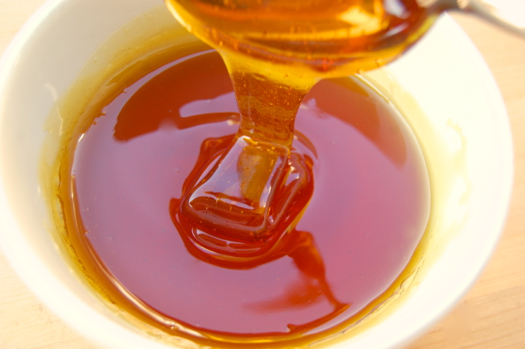
Chinese golden syrup is something of an odd duck in the syrup world. It’s an invert caramel syrup that flows at room temperature, even when undiluted with milk or water. That’s a very odd thing, since in order to get sugar syrup to caramelize you have to heat it well past the point at which it will flow once it cools. So how is this accomplished? Simply put, what you see here is a syrup made on top of a syrup, a dark caramel syrup for color and flavor, and a soft-ball stage syrup for flow. I’ll show you how it’s done.
First put half a cup of sugar in a saucepan and add about a quarter cup of water. The amount doesn’t matter much since it will cook out anyway.
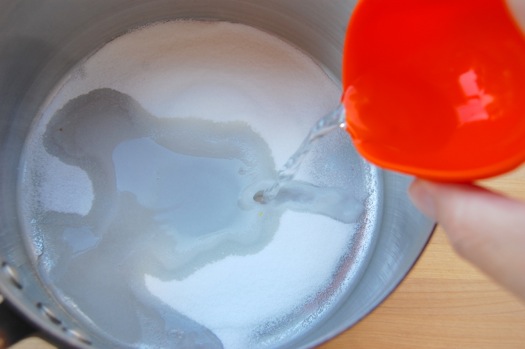
Swirl it over high heat.
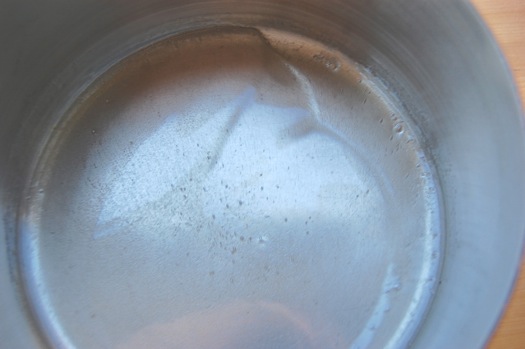
After a few minutes it will start to turn golden…
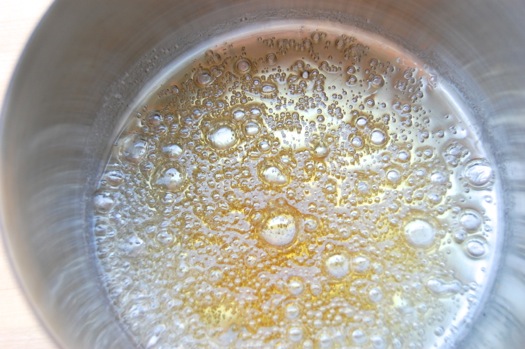
…then dark. You want this smoking a bit. Quite brown in the middle.
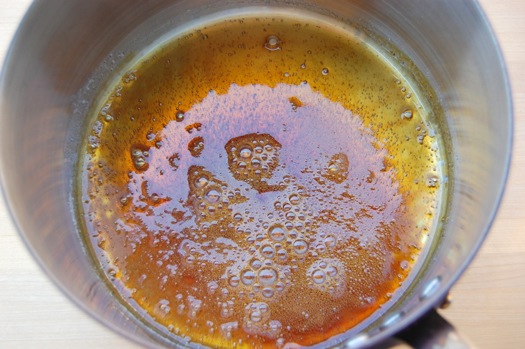
When you hit your desired darkness (since it’s really up to you), remove the pan from the heat and pour in about a cup of boiling water. Again the precise amount isn’t important here since you’ll cook most of it out later (temperature is as much a measure of a syrup’s water content as it is a gauge of how hot it is). Watch out as it will splatter some. The hot water will at once cool the caramel and keep it from turning instantly into candy.
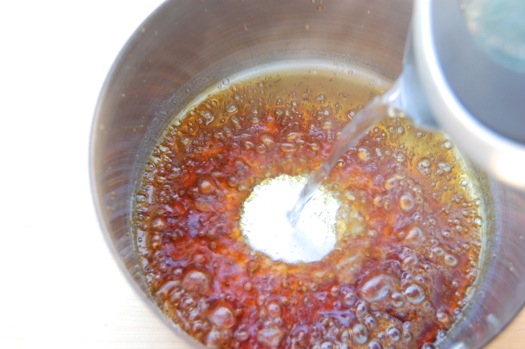
Scrape up any hardened sugar that’s on the bottom of the pan and return it to the heat.
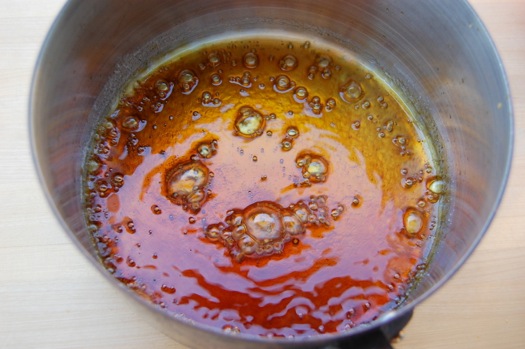
Add a full cup of sugar…
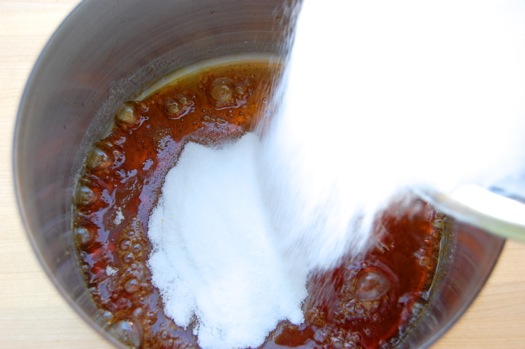
…then about a tablespoon and a half of lemon juice. A pinch of tartaric acid (cream of tartar) will also work here. This plus the heat will help break the un-caramelized sucrose molecules into pieces. The caramel you already made is acidic, but a little more acid will speed the process along.
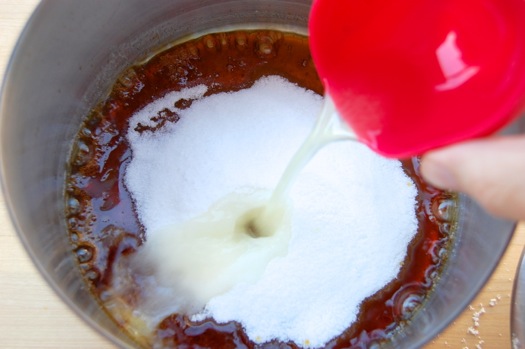
Stir all that up and let it cook again for a minute or two…
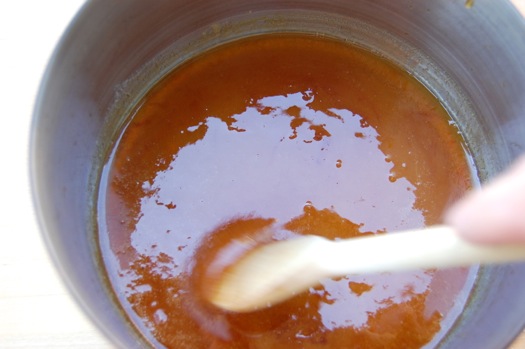
…until it’s up to the soft ball stage, about 235 degrees Fahrenheit. It will bubble more than this when you’re actually cooking it. Watch your fingers!
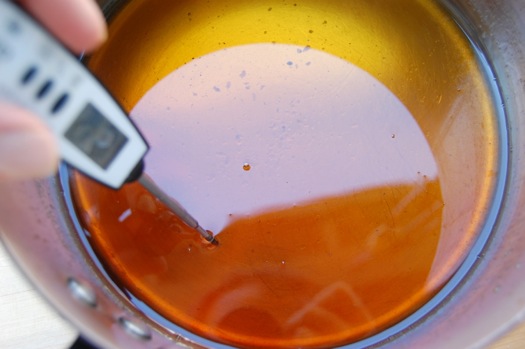
While it’s still hot pour it through a sieve to remove any bits of lemon flesh.
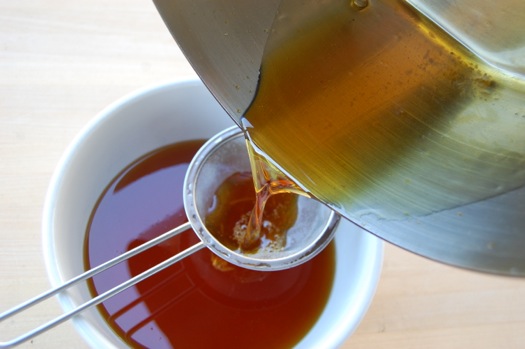
Cool and you’re done!
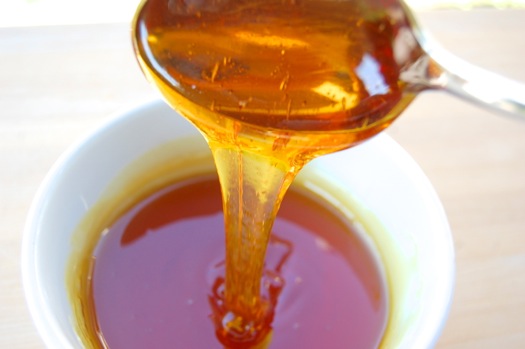
For those of you who are curious, this homemade syrup is the functional equivalent of a refiner’s syrup like Lyle’s Golden Syrup, which is to say it’s a thick, golden invert syrup. It is not a taste equivalent, however. To get that you’ll need to pay up for the real thing!
For those of you who are wondering why a syrup made of caramel and soft-ball syrup still flows at room temperature, it’s all those broken molecules. Those little single sugars simply tumble over each other more readily than the bigger sucrose molecules from whence they came. Which is cool.
This is a very handy thing to know how to make should you ever need a high-viscosity corn-syrup-like syrup but can’t make it out to the store. All you need is sugar, water and acid. Bingo!
Very very clever!
I found a very similar technique on YouTube and just streamlined it a bit. Works great! 😉
– Joe
Very Cool! I never would have thought you could make a syrup on top of a syrup.
Eva
I was wondering if that was possible…then came across someone in Australia doing that very thing on YouTube. It worked out perfectly!
Cheers,
– Joe
Wow… a good thing to learn. So if this isn’t tasting like Lyle’s, what is missing? The thrifty side of me sure would like to be able to make Lyle’s at home.
Would this work as a substitute for Karo dark, say, in a pecan pie?
Hey Brian! This definitely tastes more lemony than Lyle’s. I expect you could eliminate that by using a pinch of cream of tartar instead of the juice. Otherwise the profile is similar, but Lyle’s tastes rounder, more mellow and molasses-y. It’s a unique taste, but this I think is similar enough.
Regarding the substitution for Karo, this golden syrup will perform the same, but taste sweeter. You’ll want to cut it back by about 15% and make up the difference with more nuts or egg.
– Joe
I once tried to make some invert sugar syrup since we don’t readily find any of the glucose or glucose/fructose syrups in my country. Unless you buy it by the 10 gallon bucket which I don’t intend to be doing anytime soon. The acid I used was citric acid (which we find in a crystalline form sold as “lemon salt”). Maybe I put in too much but the final thing tasted awful. Awful enough to scare me away from syrup making for a while. Should have stuck with the good ol’ lemon juice. Nothing beats the nature, but I still wonder if the syrup will still taste lemony.
you can use cream of tartar instead. here’s the recipe i’ve been using for several years. i stop the cooking at 234 degrees though. make sure to let it cool with the lid on.
http://www.chefeddy.com/2009/11/invert-sugar/
Thanks very much, Candide!
– Joe
That is so cool! I am trying to think of clever places to use this neat new trick. Your a gem, thanks for sharing
I love what I do! 😉
– Joe
Why is the starting caramel acidic?
Hi J!
That’s another mystery of Maillard reactions. The darker a caramel gets, the more acidic it becomes. Obviously a lot of the xyz molecules that browning reaction create are acidic. Just what they are no one knows!
Thanks for a great question!
– Joe
A family connection mistakenly substituted pure maple syrup for Karo–the best mistake ever! And the best pecan pie ever.
I believe it, Sally! Thanks for the note!
– Joe
Hi Joe,
Instead of lemon juice, can I add vinegar instead or any other additive that does not have flavour?
Yes, Thio, you certainly can use vinegar instead!
Great question. Thanks,
– Joe
The way my family has been doing it for many years (we make mooncakes annually) is put the sugar, water, and lemon juice in a wok, slap on the cover and bring to the boil. When there is roaring steam coming out of the vessel, we turn down the heat and uncover it. It is then simmered until it reaches a honey-like consistency. It always produced that rich dark colour, and there has never been any sugar crystals on the sides of the wok, which seems to be common when making any kind of syrup.
I made this twice. The first time I let it cook longer than you said because I read somewhere else you get a better flavor the longer it simmers. Well it crystallized on me although I managed to fix it and it was very, very tasty even compared to Lyle’s.
I decided to do another batch and follow your instructions exactly. The syrup was much thicker although not as tasty as the first batch. However, long after it cooled, it started crystallizing and so far I am just stirring it and it disappears. Not sure what will happen overnight.
It did crystallize not long after this post. I reheated and didn’t stir it while it was cooling and it seems fine now. My first batch waited til this morning to crystallize so redoing it without stirring to see what it does, although it may not have enough water in it.
Hey Cheryl!
Yes that makes sense on the cooking. The darker your caramel gets, the more the sugar will break up into various “whatsits” and the thinner it will become. As far as the crystallization, this is one of those recipes where you have to make sure you don’t leave many “seed” crystals behind…i.e. brush them down into the hot syrup. Mine crystallized after about a week, so I simply reheated it, but I’m also discovering that this is more crystal-prone than I initially thought.
Thanks for the comment!
– Joe
Hi Joe,
Thanks very much for the golden syrup recipes. I followed your instruction, but I made the caramel a little bit darker. The syrup look very beautiful and did not crystallize after three months. Actually, I made this syrup for the moon cake and had to wait that long. I might add a little more lemon juice and I cooked at a very low heat to avoid strong boiling.
I had tried to make syrup for the moon cake but had not been very successful until this time. The syrup gave my moon cakes a wonderful bright golden brown color that I looked for so long.
Wonderful!
Thank you very much for writing to me with the good news! I am certain your moon cakes were much better than mine!
Cheers,
– Joe
Hi Joe,
If I want the syrup to less vicious and slightly more free flowing can I dilute it with a little bit of water and if so at what stage of the process?
Hello Thio!
You can add more water to thin it if you like. Once it’s made and cooled you can simply stir it in. Be warned that a little water goes a long way so add it by the drop. Note that the thinner it gets the shorter the time it will keep, thin syrups tend to ferment! Cheers and best of luck!
– Joe
If I were to use vinegar to replace lemon juice how much would the amount be?
Hey Shirlynn!
Simply use an equal amount.
– Joe
Hey Joe! Being that this was heated to the softball stage… Could you use this for italian meringue? I guess I could simply perform this by portioning out half of the sugar for caramel and half for the later addition?? My guess is that the lemon juice would also elimonate the need for cream of tartar….
Interesting idea, Kenny!
There’s only one way to find out: try it! Then get back to me with the results if you will!
Cheers,
– Joe
How much golden syrup does this recipe yield?